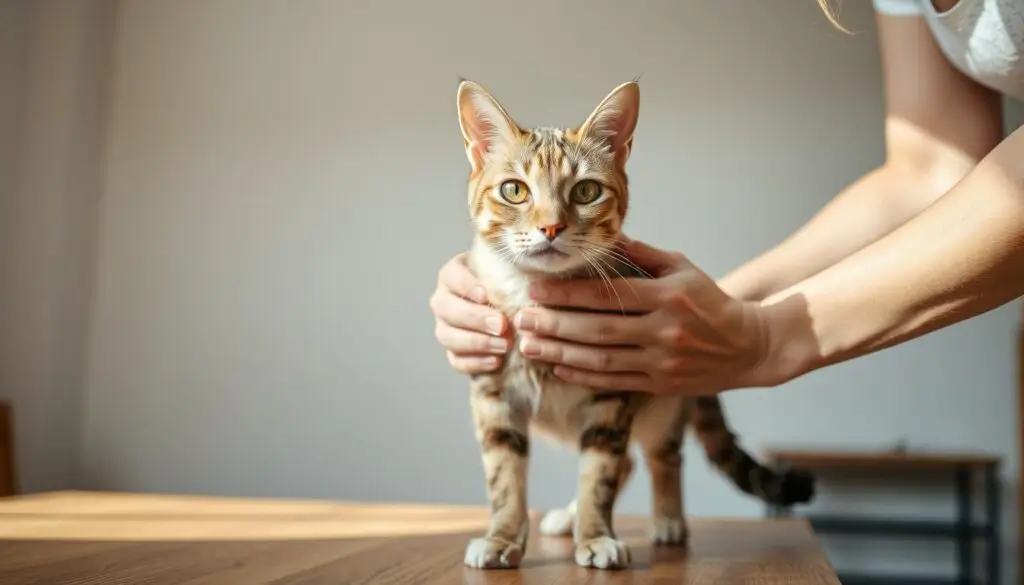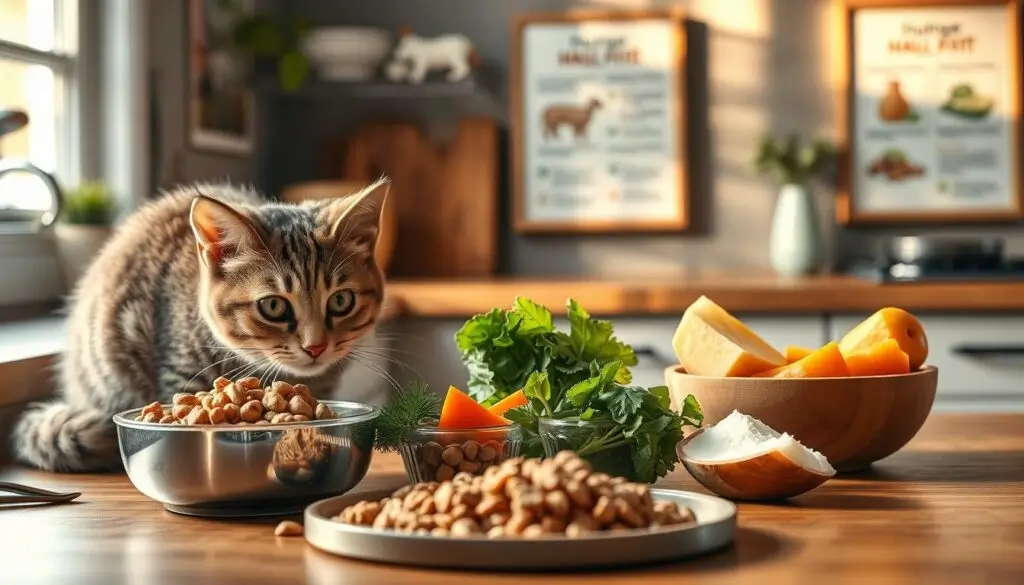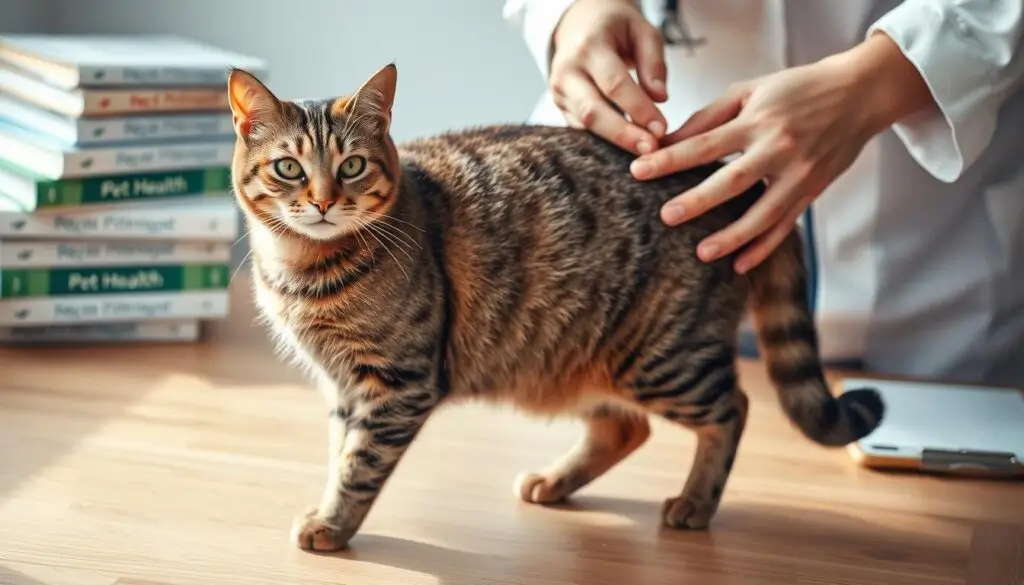Cat Health Weight: What You Need To Know About Feline Obesity
When you brush your hand over your cat’s ribs and feel more than just fur, it’s time to ask hard questions. Feline obesity prevention is not just about looks. It’s about adding years to your cat’s life. Over 60% of cats in the U.S. now struggle with excess weight, making it a silent epidemic.
A cat’s ideal body condition score (BCS) is 5 on a 9-point scale. Yet, many owners ignore the signs until their pets face serious health issues. Even 2 extra pounds can lead to severe health risks. This guide will help you protect your cat’s wellbeing with science-backed steps.
Table of Contents
Key Takeaways
- Over 60% of U.S. cats are overweight or obese, per the Morris Animal Foundation.
- A BCS score of 5/9 marks ideal cat health weight; scores above 6.5 signal risks.
- Obesity raises diabetes risk by 3x and shortens lifespans by years.
- Wet food’s 90% water content aids hydration and weight control.
- Safe weight loss targets 1–2% of body weight weekly (4–6% monthly).
Understanding Healthy Weight Parameters for Cats
Cats’ healthy weight depends on their breed, age, and body type. Knowing these details is crucial for keeping them in good shape. Sadly, over 61% of U.S. cats are overweight or obese, making this knowledge very important.
Weight Ranges Based on Cat Breeds
Some breeds, like Maine Coons, can be healthy at 20 pounds. Others, like Siamese, do well at 5 pounds. Here’s a guide to help:
| Breed | Healthy Range (lbs) |
|---|---|
| Siamese | 5–10 |
| Persian | 7–12 |
| Maine Coon | 10–25 |
| Bengal | 8–15 |
Body Condition Scoring Systems
Vets use a 1–9 scale to check a cat’s health. A score of 4 means they’re just right. Here’s what a 4/9 score looks like:
- Rib cage easily felt without excess fat
- Waist visible when viewed from above
- Abdominal fat pad minimal
Growth and Weight Changes Throughout Life Stages
Kittens grow fast, reaching 8–10 lbs by age 1. Adult cats usually peak at 10–12 lbs. Seniors might need a bit less food. Sudden weight changes could mean health problems, like thyroid issues.
Keeping cats at a healthy weight is key. Regular vet visits are important. They help catch any weight changes early on.
The Rising Epidemic of Feline Obesity in America
Over 61% of U.S. cats are now overweight or obese, a 2022 survey found. This cat health weight crisis is the most common preventable disease in cats. Yet, many owners don’t realize it: 28% think overweight pets are normal, and 7% see severe obesity as healthy.
Owner habits contribute to the problem. Cats fed mostly dry food are 2.4x more likely to be obese. Indoor cats and overfeeding treats make it worse. Media also plays a part by showing plump cats as cute, which can be risky for overweight cat health.
| BCS Score | Weight Excess | Risk Level |
|---|---|---|
| 1-4 | 0-7% | Healthy |
| 5 | 10-19% | Overweight |
| 6-9 | 20-30%+ | Obese |
Breeds like the British Shorthair and Maine Coon are at higher risk. Neutered cats can gain 3-53% weight after surgery, harming their health. Despite 49% of vets talking about weight yearly, only 19% of owners report successful weight loss. This shows we need more education and care.
Health Risks Associated with Overweight Cats
Managing a cat’s weight is key to avoiding serious health problems. Being overweight can affect a cat’s life span and overall health. The Association for Pet Obesity Prevention (APOP) reports that 59% of U.S. cats are overweight or obese. This doubles their risk of serious health issues.
“Obesity in pets is a silent killer,” says the APOP, noting obese cats face a 2.8-fold higher mortality rate by middle age.
Here are some major health risks:
-
- Diabetes and Insulin Resistance
Being overweight can make cats 2x more likely to need insulin shots. High carb diets can also make it harder for cats to manage blood sugar. - Joint Damage
61% of older cats show signs of arthritis. Extra weight puts more stress on joints, speeding up wear and tear. Even a small amount of extra weight can cause a lot of joint pressure. - Heart Strain
Obesity can lead to high blood pressure, causing strokes and eye damage. Overweight cats are 3x more likely to have heart disease, with 25% of cases linked to obesity. - Lifespan Reduction
- Diabetes and Insulin Resistance
Obese cats live 5 years less than their healthy peers. 40% of obese cats develop serious health issues like liver disease, kidney failure, or skin problems that make it hard to move or groom.
| Health Risk | Incidence Rate |
|---|---|
| Diabetes | 2x higher risk |
| Osteoarthritis | 61% of senior cats |
| Hypertension | 30% of obese cats |
| Reduced lifespan | 5 years shorter average |
It’s important to act early. Vets suggest losing 1-1.5% of body weight each week. Studies show that play and low-carb diets can help.
How to Assess Your Cat’s Weight at Home
Keeping an eye on your cat’s weight is crucial for cat weight management. With 59.5% of cats being overweight, regular checks at home are vital. They help you see if your cat is getting closer to a healthy weight for cats. Follow these steps to check your cat’s weight between vet visits.
Visual Assessment Techniques
Begin by looking at your cat’s shape:
- Look from above: A healthy weight for cats shows a clear waistline behind the ribs.
- View from the side: The belly should curve upward behind the ribs, not droop.
Hands-On Methods
Feel your cat’s body with your hands. Ribs should feel like the back of your hand with a bit of softness. If you can’t find the ribs, your cat might be too heavy. Compare this to the following touch points:

| Body Part | Feel | Weight Status |
|---|---|---|
| Ribs | Like the back of your hand | Ideal |
| Ribs | Like knuckles | Possible underweight |
| Ribs | Like the palm | Overweight risk |
When to Consult Your Veterinarian
Get professional advice if your cat:
- Loses or gains more than 10% of their body weight.
- Experiences quick weight changes without diet changes.
- Has a BCS score below 3 or above 5.
Use a baby scale for precise tracking. Sudden weight changes might mean health problems like hyperthyroidism or kidney disease.
Common Causes of Cat Health Weight Issues
Keeping your cat at the right weight is key. It’s important to know what can go wrong. There are two main reasons: things about the cat itself and what they eat.
Animal-specific factors include changes in the cat’s body. Neutering can make them eat more because their metabolism slows down. Cats in their middle years (8–12 years) are more likely to get fat because their metabolism is slower.
Being indoors means they don’t get to move around much. Conditions like osteoarthritis make it hard for them to move, leading to weight gain. Health problems like hypothyroidism or acromegaly also make it tough to keep the weight off.
Diet-related causes are a big part of the problem. Dry food has too many carbs and calories, leading to overeating. Feeding them all they want can also cause them to eat too much. Treats add extra calories that aren’t counted.
Studies show 63% of cats in developed countries are overweight. Overfeeding is the main reason. Environmental factors like boredom or competition with other cats also play a part.
To fix these issues, you need to make changes. Adjusting how much food they get and making their environment more interesting are good steps. Taking these actions can help you keep your cat at a healthy weight.
Nutrition Fundamentals for Weight Management
Effective cat diet tips start with understanding how to read labels and balance meals. Proper nutrition is key to safe weight loss for cats. Start by focusing on high-quality proteins and avoiding empty calories.

Decoding Cat Food Labels
- Look for meat-based protein sources listed first, not grains or fillers.
- Check guaranteed analysis for at least 26% crude protein (dry matter basis) for adults.
- Avoid diets with >10% carbohydrate content—cats thrive on protein-rich meals.
Portion Control Strategies
Use a kitchen scale for precision. Feed 2-3 measured meals daily instead of free-choice feeding. Aim for 80-90 calories per pound of ideal body weight per day.
Wet vs. Dry Food Considerations
Wet food’s high moisture content boosts hydration and satiety. Dry food’s higher calorie density requires strict portion tracking. Mix both types cautiously to avoid overfeeding.
Safe Treat Options
- Limit treats to
- Opt for protein-rich options like cooked chicken or turkey.
- Use playtime or brushing as non-food rewards to avoid calorie excess.
“Always consult your vet before changing your cat’s diet. They can calculate precise calorie needs based on age, activity, and health status.”
Exercise and Enrichment for Indoor Cats
Exercise is key for weight loss for cats. Indoor cats need stimulation to feel like they’re hunting. Short play sessions and creative feeding can help a lot.
- Interactive play: Use feather wands or laser pointers for 5–10 minute bursts. Reward with small treat portions to mimic hunting success.
- Vertical spaces: Cat trees or window perches encourage climbing. Multi-level setups let cats jump and explore.
- Puzzle feeders: Hide kibble in toys or scatter meals across the house to turn eating into a workout.
- Outdoor adventures: Leash-trained cats can enjoy supervised walks. Secure enclosures (“catios”) offer safe outdoor access.
“Effective weight loss in cats typically relies on reducing caloric intake and increasing calorie expenditure.”
Start slow with overweight cats. Begin with 2–3 short play sessions daily, gradually increasing duration. Vertical shelves or low platforms help even less agile cats build strength. Rotate toys to avoid boredom—chasing, climbing, and foraging activities keep motivation high.
Combine mental and physical stimulation. Food puzzles paired with daily play create a balanced routine. Consistency over intensity matters most. Track progress with weekly weigh-ins and adjust plans with your vet to ensure safe, sustainable weight loss for cats.
Special Weight Management Considerations
Effective cat weight management often needs special plans. This is true for indoor cats, homes with many pets, and older cats. Each group has unique needs to stay healthy.
In homes with many cats, fights over food can make it hard to keep them at a healthy weight. Here are some solutions:
- Timed feeders to control portions for each cat
- Microchip-activated feeders for personalized diets
- Raised feeding platforms for cats with mobility issues
Senior cats have slower metabolisms and arthritis. They need more protein but fewer calories. Vets help with slow weight loss, aiming for 1% a week to protect their aging bodies.
Cats with diabetes or kidney disease need special diets. For example, cats with joint pain might do better with low-stress activities like puzzle feeders. Always talk to your vet to make sure you’re meeting their health needs.
Regular weigh-ins every 2–4 weeks help track progress. Small changes in feeding schedules or food texture can keep them on track. This way, you can meet their individual health needs.
Working with Your Veterinarian on a Weight Loss Plan
A weight loss for cats plan needs a vet’s help to stay safe. Vets check for health issues like thyroid problems or arthritis before starting. Since over 58% of pets are overweight, getting expert advice is key for feline obesity prevention.
- Diagnostic Checks: Bloodwork and body condition scoring find health risks before starting.
- Meal Planning: Vets use tools like the Pet Nutrition Alliance calculator to figure out daily calories.
- Monitoring: Cats should lose 1-2% of their body weight weekly, with weigh-ins every two weeks.
Prescription diets are often suggested for cats over 20% overweight. These diets offer balanced nutrition while cutting calories. Owners should keep track of treats, limiting them to 10% of daily calories. For example, a 10-pound cat losing 0.5% weekly needs careful portion control.
Vets adjust plans as needed to keep muscle mass up. Regular check-ups help avoid problems like hepatic lipidosis. Working with a vet helps owners create a lasting plan for their cat’s health. This can extend their cat’s life and improve their quality of life.
Success Stories: Transforming Overweight Cats to Healthy Weights
Cat diet tips and strategies to prevent obesity work. Real results show cats can thrive with patience. The Fit Pets for Rescues (FPR) program proves this, with cats like Spudgie losing 25 pounds over years. Below are key examples from the 2025 FPR Challenge:
| Cat Name | Starting Weight | Final Weight | Timeframe |
|---|---|---|---|
| Spudgie | 50 lbs | 25 lbs | 2 years |
| Big Boy Daemon | 25 lbs | 17 lbs | 6 months |
| Zeezee | 26 lbs | Healthy | 18 months |
Timeline Expectations:
- Months 1–3: Veterinary guidance sets safe targets (1–2% weight loss weekly).
- Months 4–6: Adjust cat diet tips based on progress.
- Months 7–12: Celebrate milestones like increased playfulness and lower vet costs.
Maintaining results requires consistency. Feline obesity prevention demands lifelong habits:
- Weekly weigh-ins using home scales.
- Switching to high-protein Purina formulas for sustainable progress.
- Tracking activity with interactive toys to replace high-calorie treats.
The FPR program’s 2025 challenge awarded $30,000 in prizes to 19 cats. Sponsors like Purina supported telemonitoring tools, proving that feline obesity prevention is achievable. With 15 of 19 cats losing weight, these stories show that even extreme cases like 20+ pound losses are possible. Patience is key: 20% weight loss over a year is safer than rapid diets.
Conclusion
Cat health weight is key to their overall well-being. Over 60% of U.S. cats are overweight, which can lead to serious health issues. These include diabetes and a fivefold increase in lameness rates.
Being overweight affects more than just a cat’s health. It can shorten their life and make everyday activities uncomfortable. Keeping a cat at the right weight is crucial for their happiness and health.
Preventing obesity starts with early detection. Regular checks at home and vet visits are essential. For overweight cats, losing weight slowly is best. This reduces joint pain and may even reverse diabetes in some cases.
Choosing the right diet is important. Diets with fewer calories help cats lose weight safely. This way, they get all the nutrients they need without gaining weight.
Keeping a cat healthy long-term requires consistent effort. Changing their eating habits and adding playtime helps. Tools like scales and body condition scoring charts track progress.
Even small changes can make a big difference. Replacing treats with toys is a good start. It helps cats stay healthy over time.
Every cat’s journey is different, but the goal is the same: prevent obesity. Starting with kittens helps set a healthy path. For adult cats, losing weight takes time but is possible with the right plan.
Working with a vet is key. They ensure the plan fits the cat’s health and lifestyle. This way, cats can live happy, healthy lives.

